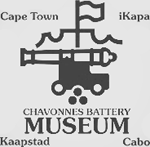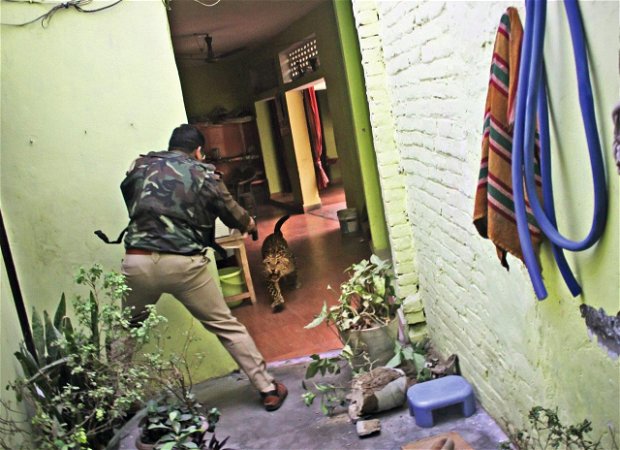Ajay Kumar
TITLE: I could hear leopard crying in pain after it was shot
CATEGORY: Stenin Press Photo Contest: TOP NEWS 3rd Place
PHOTOJOURNALIST Ajay Kumar received an early morning call to say a wild leopard had been spotted near houses in Lucknow, India. When he arrived at the scene, he followed a crowd of people, including police officers, who chased the animal until it was cornered in a house. When a police officer fired at the leopard, Kumar captured the moment, which won him the third prize in the hard news category of the prestigious Andrei Stenin International Press Photo Contest. This remarkable image is one of 67 of the contest's award-winning pictures on exhibition at the Chavonnes Battery Museum in the Waterfront until February.
Describing the drama, Kumar, who works for The Times of India, said: "When I reached the house where the leopard had tried taking shelter, I started following the police officer who had shot at the animal. As it lunged at the officer after being shot thrice, I aimed my camera at it from behind the officer, aware that I could be the animal’s next victim. However, I did not flinch and continued taking pictures. It was only when I left the room a few moments later that fear, and the enormity of what could have happened had anything gone wrong, hit me".
Immediately after taking the picture, the photojournalist retreated from the house, but needed to get back in again to follow the injured leopard. "Knowing that I was in danger, pursuing a wild animal, the adrenalin rush ensured that I continued the chase," he said.
However, residents had blocked the entrance to house. Kumar climbed onto an adjoining house, from where he jumped back into the yard of the house where the leopard was.
"Even as I reached the roof of the adjoining house, I could hear the leopard crying in pain. Minutes after I was able to re-enter the house, its painful cries subsided till there was absolute silence and the animal was dead. The moment was one of deep anguish for me. Here was an animal that, for no fault of its own, strayed into an urban area.
"Without having injured or even attacked anyone, even though it found itself threatened, the animal was killed. There were no attempts to capture it alive or give medical assistance once it had been shot. Ensuring that it remained alive was nobody’s concern. The few minutes that I spent in the adjoining room, listening to the animal cry in pain, felt like hours and have been some of the most helpless moments for me".
Having strayed into a crowded village in Lucknow, the capital of Uttar Pradesh, the most populous state in Northern India, the leopard caused panic among residents. Urbanization and developments are increasingly encroaching on leopards’ territory in forests in India, pushing them closer to the villages. However, Kumar said interactions between humans and leopards were rare in Lucknow. Leopards were spotted once or twice a year on the outskirts of the city, the photojournalist said.
His photograph was taken on the last day of a three day long mission to capture the animal.
"Its attempted rescue was a tragic, three-day long clumsy and half-hearted operation which ended with its death," said Kumar.
The picture led to a criminal complaint being laid against the officer because "no attempts had been made to tranquilize the animal," but he was acquitted.
The photographer said his main aim that day "was to get the best pictures of what had turned out to be a disastrous rescue attempt. It was clear by then that other than killing the leopard; authorities could do little else as they did not have either equipment or experience to capture it alive.
"An assignment like this is a once in a lifetime opportunity for a photographer like me, posted in a city where routine assignments range from political affairs to urban infrastructure."
When Kumar heard his picture was among the award-winners, he felt "a rush of pride and excitement. Not only was this my first international competition, I was also the only Indian to have won any award in this contest. For a young photojournalist like me, it has been an incredible honor to have my work recognized. It has also instilled a sense of confidence in me and I know that I can trust my instinct and take even better photographs".
The photojournalist, a stringer at the Lucknow edition of The Times of India since 2014 and founding member of India's The Youth Photojournalist Association (TYPA), believes "a photograph has the power to bring change, highlight a wrong or point out something good".
*The Stenin International Press Photo Exhibition features photographers from the following countries: India, South Africa, Egypt, Russia, Iran, Iraq, Israel, Bangladesh, Turkey, Germany, Italy, Spain and Belarus. Entrants competed in four categories: Top News, Sports, My Planet and Portrait: A Hero of Our Time.
The Andrei Stenin International Press Photo contest was established on December 22, 2014. The contest is run by Rossiya Segodnya under the auspices of the Russian Federation Commission for UNESCO. It is an annual contest for young photojournalists aged between 18 and 33 years old. It is Russia’s only platform for discovering new photojournalists and for allowing them to make a name for themselves on the world photojournalism stage






Share This Post